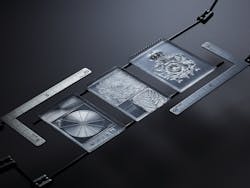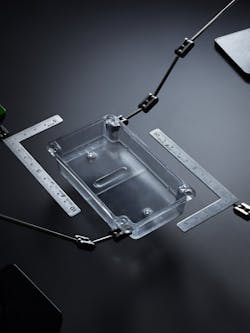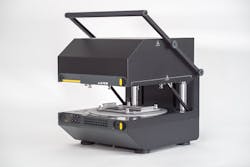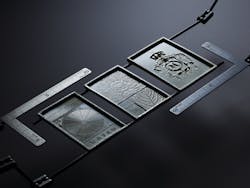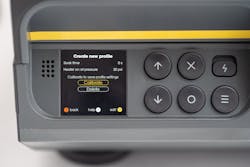Medical Device Maker Enhances its Packaging 3D Printing Workflow with a Benchtop Multiplier Pressure Former
In the realm of advanced medical device development, Switzerland’s Oertli Instrumente AG has transformed its prototyping and packaging processes by integrating the Mayku Mulitplier pressure former into its 3D printing workflow.
Oertli Instruments sees its mission in the development and production of surgical platforms, instruments and consumables for ophthalmology surgery, according to Malte Heuer, a project lead in vitrectomy surgery at Oertli. He says the company has always committed itself to consistently high quality and absolute reliability.
Packaging Prototyping Needed Improvement
The R&D team would design the packaging and manufacture a limited visual prototype using FDM 3D printing, he explained. “This prototype wouldn’t have any functionality, as the packaging undercuts that hold the components in place wouldn’t be flexible enough,” he said. “A functional prototype couldn’t be printed with any 3D printing technology due to the reduced wall thickness.”
Because FDM 3D printing has limitations such as lower resolutions and rougher finishes, it is a less-ideal solution for creating detailed and precise prototypes. Also, because FDM prints are anisotropic, they are prone to breaking along the layer lines.
Prior to introducing the Multiplier into our R&D workshop, we were not able to produce prototypes that resembled the final packaging.
- Malte Heuer, project lead in vitrectomy surgery at Oertli Instrumente AG
Once approved by the product management team, Heuer said the design would be sent to the packaging supplier, who would make a prototype in approximately three weeks. The functional prototype would then be shipped back and tested by customers, after which feedback would be gathered. This process would be repeated until the perfect design was found.
The design iteration process was inefficient, so when Heuer took charge of the medical packaging prototyping at Oertli, he sought a technology that would make prototyping more agile. “A fast Google search looking for desktop, but powerful, thermoforming machines revealed the Multiplier, and I quickly saw its potential within Oertli, so I acquired it from Mayku’s Swiss partner Dim3nsions,” Heuer said.
The company was able to easily integrate the Multiplier into the existing prototyping workflow, preserving key aspects that were already efficient and optimizing those that caused issues, Heuer said. “I still use Solidworks to design the packaging prototype; however, instead of 3D printing a visual prototype to present to the product management team and then outsourcing to the packaging supplier, I 3D print a thermoforming template of the design,” he said. “I then use the Multiplier to create high-fidelity prototypes that I present to the team and testers. All of this can be done within a day.”
How the Multiplier Works
According to Alex Smilansky, Mayku’s co-founder and CEO, the Multiplier pressure former allows users to form a flat thermoplastic sheet around a 3D printed template. First, the machine heats up a sheet of thermoplastic to the required temperature. “The auto-levelling system keeps the sheet level allowing it to get to the precise temperature for optimal forming, giving the user a reliable consistent result every time,” he said.
When the softened sheet is ready, the user brings it down over the template to be formed; up to 60 psi of pressure is then released over the sheet, pushing it into the finest details of the template. The sheet then cools and can be removed for post-processing. Smilansky says the machine is compatible with hundreds of thermoplastics as low as 100 microns thin and above 5 mm thick, and that cycle times are in minutes.
When asked how the multiplier differentiates from other similar technology, Smilansky said, “As opposed to vacuum forming, pressure forming provides five times the force per square inch, meaning users are able to achieve much finer details and work with thicker advanced thermoplastics.”
The pressure former brings the precision of injection molding to engineers’ benchtops and allows for the creation of isotropic thermoplastic parts with sub-micron details, but also in thick materials, Smilansky explains. “The cost per part and time per part is very low and the repeatability and replicability is very high, meaning users can make single parts or batch productions with high consistency,” he said. “The machine is a great fit when parts need to be made fast from production-grade thermoplastics and really comes into its own when series productions are needed.”
To get a successful part, users need to design for pressure forming, which means creating parts with no undercuts, that use air vents to ensure air flow around the template, have draft angles on straight walls and are not taller than they are wide.
- Alex Smilansky, Mayku’s co-founder and CEO
Device specifications include:
- Maximum forming temperature of 225°C
- Working area is a 400 mm circle
- Pressure up to 60 psi
- Compatible with hundreds of thermoplastics.
Users can create and store custom profiles for any compatible thermo-formable material. Custom mode also helps increase accuracy by giving engineers extended control over the machine’s heat and pressure capacities.
The machine’s reducing plate accessory simplifies material sourcing and testing by condensing the forming area down to a more widely available A4 or U.S. letter format, extending the range of thicknesses from as low as 0.1 mm to more than 5 mm.
READ MORE: Rising Demand for Medical Devices Fueling Market Growth
Turning a Negative (Mold) into a Positive
Because of the nature of pressure forming, there are some important design considerations to ensure the best results are achieved, Smilansky says. “To get a successful part, users need to design for pressure forming, which means creating parts with no undercuts, that use air vents to ensure air flow around the template, have draft angles on straight walls, and are not taller than they are wide,” he said.
Heuer explains that Oertli experienced some challenges in thinning of the foil in areas with too high ratios (width-to-depth) and bridging in areas of thin gaps.
“We switched from negative to positive molds to move the functional areas to regions of low stretch,” he explained, “and found the minimal gap size to reduce bridging by manipulating the printed model and then reforming.” He says that the best results are achieved with high-temperature resin printing or filaments such as nylon or Nylon CF. “At this point, we are using standard PLA and discarding the template after a certain number of molds,” he said.
Smilansky adds that when combined with high-resolution 3D printing, the Multiplier pressure former can replicate the level of detail that can be achieved with resin printing in production-grade thermoplastics. “All at a fraction of the cost of outsourcing,” he noted. In addition, because the machine has cycle times that are only minutes long, parts can be replicated fast and accurate series productions are made possible on the benchtop.
“Effectively, when coupled with a high-resolution printing system, the Multiplier can reduce the manufacturing time of a batch produced element by an order of magnitude,” Smilansky said.
Integrating Multiplier Proves Beneficial
One of the key benefits of a pressure-formed part is that it is made from real production-grade thermoplastic sheets. Because the sheet is precisely formed around a part it maintains isotropic properties, Smilansky explains. In addition, the machine can achieve high repeatability and replicability as the dimensional accuracy remains unchanged from form to form. “Original sheet material properties are also transferred, making the process more suitable to industries and applications relying on specific material grades and properties,” he said.
The Multiplier enables Oertli to create prototypes of pressure-formed thin foil plastic packaging. “Prior to introducing the Multiplier into our R&D workshop, we were not able to produce prototypes that resembled the final packaging,” Heuer said.
The pressure former has significantly enhanced Oertli’s prototyping capabilities. “When used in conjunction with our 3D printer, it has extended our workflow towards the production of high-fidelity prototypes, reducing the design iteration cycle from three weeks to just one day,” Heuer said. “It has helped to create prototypes with the needed properties, facilitating better testing and feedback processes.”
About the Author
Sharon Spielman
Technical Editor, Machine Design
As Machine Design’s technical editor, Sharon Spielman produces content for the brand’s focus audience—design and multidisciplinary engineers. Her beat includes 3D printing/CAD; mechanical and motion systems, with an emphasis on pneumatics and linear motion; automation; robotics; and CNC machining.
Spielman has more than three decades of experience as a writer and editor for a range of B2B brands, including those that cover machine design; electrical design and manufacturing; interconnection technology; food and beverage manufacturing; process heating and cooling; finishing; and package converting.
Email: [email protected]
LinkedIn: @sharonspielman
Facebook: Machine Design
YouTube: @MachineDesign-EBM
